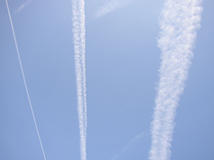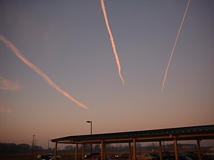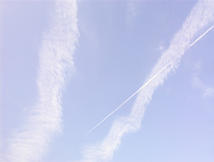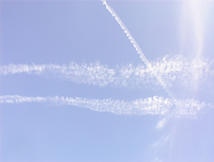Mixed Contrails - Clouds Protocol
Contrails - Mixed
|
Range of Contrails This is a very nice photo showing a range of contrails from a newly-created persistent contrail (left) to a medium-wide (center) and very wide (right) persistent spreading contrail. The likely explanation for this is three aircraft following the same route one after the other, with a cross-wind at altitude blowing the contrails to the right. Plentiful water vapor is allowing the contrails to widen with time as they blow along in the wind. Photo by Carol Clark, Oregon. |
|
|
Contrails Advecting This group of three contrails was captured by Ed Donovan of Berry Shoals Intermediate School in South Carolina. It shows a series of contrails formed by planes following a very similar route, but then being advected (moved) to the left by upper level winds. Note that the leftmost contrail is the widest, suggesting it has been forming the longest, while the rightmost contrail is still quite thin. Also note that the apparent convergence of these contrails is likely attributable for the most part to perspective. A useful objective measure for spreading vs non-spreading contrails is to compare them to the width of your finger held at arm's length. In this case, the left-most contrail is probably the only one that would exceed that width. |
|
|
Old contrails with a new contrail forming This photo shows a contrail being formed (although the plane cannot be seen in the photo it is at the point of the narrow contrail). This contrail is persistent - it is not disappearing behind the plane. The other two braod cloud structures are also likely to be contrails, but very old persistent contrails which have spread a great deal. Except for their shape, there is little to distinguish these from natural cirrus. Note how much wider they are than the new contrail however. This is a good illustration of the reasons scientists want to know more about contrails: they can grow to fill large portions of the sky. Photo taken by Lin Chambers in southeastern Virginia. |
|
|
Persistent Contrail The contrail going diagonally through this picture is persistent. In contrast to the two very wide contrails going across the photo, it has not spread very much. Photo by Lin Chambers in southeastern Virginia. |
|
|
Forming contrail with faint old contrail This photo captures a passing plane leaving a very defined thin contrail, with a very faint and diffuse old contrail just barely visible. Along with a clear blue sky, these are indicators of a moderately dry atmosphere. Photo taken by Dr. Debra Krumm at Lassen Volcanic National Park near Mineral, California. |










